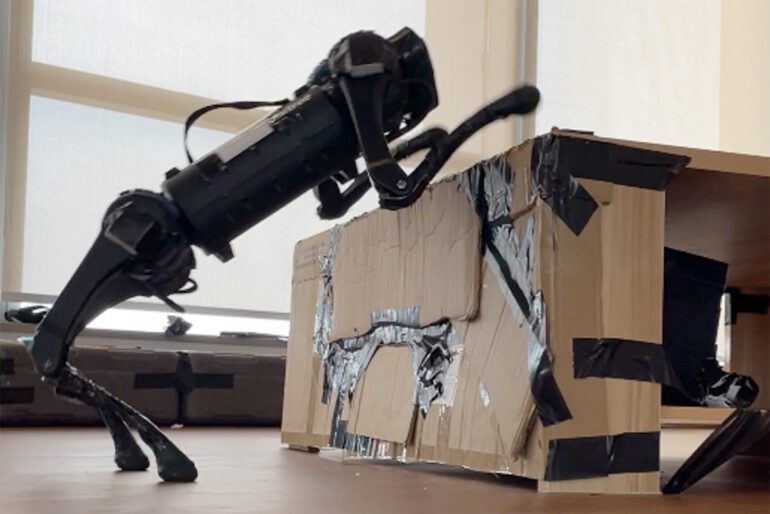TL;DR:
- Researchers at Stanford University and Shanghai Qi Zhi Institute unveil an AI-driven algorithm for autonomous robo-canines.
- The algorithm enables robo-canines to autonomously navigate obstacles using computer vision and agility.
- It simplifies reinforcement learning through a streamlined reward system.
- Real-world tests show robo-canines can climb heights, leap gaps, crawl under barriers, and squeeze through narrow spaces.
- This breakthrough heralds a new era of autonomous, versatile, and self-sufficient robotic rescue systems.
Main AI News:
In an era when unforeseen crises like earthquakes, fires, and floods demand swift responses, envision a team of robotic rescue dogs emerging as the first line of aid. These battery-operated quadrupeds, harnessing the power of cutting-edge AI technology, leverage computer vision to assess obstacles and employ canine-like agility to surmount them.
Pioneering this noble vision, a collaboration between AI researchers at Stanford University and the Shanghai Qi Zhi Institute has yielded a groundbreaking vision-based algorithm. This algorithm equips these robo-canines with the ability to conquer formidable challenges, including scaling heights, leaping across chasms, maneuvering beneath thresholds, and navigating through narrow crevices. Essentially, this algorithm serves as the brainpower behind these remarkable robotic dogs.
“The autonomy and the spectrum of intricate skills that our quadruped robot has acquired are truly remarkable,” expressed Chelsea Finn, an accomplished assistant professor of computer science and the senior author of a forthcoming peer-reviewed paper, which will be presented at the upcoming Conference on Robot Learning. “Notably, we’ve achieved this using cost-effective, off-the-shelf robots – in fact, two distinct off-the-shelf models.”
The key innovation, as articulated by the authors, lies in the autonomy of these robo-canines. They possess the ability to evaluate physical impediments and autonomously conjure up a repertoire of agility skills, solely based on the obstacles that lie before them.
“What we’re accomplishing is an amalgamation of perception and control, leveraging images from a depth camera affixed to the robot, and deploying machine learning to process these inputs, thereby orchestrating leg movements to navigate over, under, and around obstacles,” explained Zipeng Fu, a dedicated doctoral candidate in Finn’s research laboratory and co-first author of the study, in collaboration with Ziwen Zhuang of the Shanghai Qi Zhi Institute.
Streamlining for Optimization
While previous incarnations of robo-canines have exhibited athletic prowess akin to “parkour,” these latest creations stand out for their self-reliance and versatility.
“Our robots possess both vision and autonomy – a form of athletic intelligence that enables them to evaluate a challenge and independently select and execute parkour maneuvers based on the situation at hand,” Fu elaborated.
Traditional learning methods often rely on intricate reward systems, necessitating fine-tuning for specific physical obstacles and thus limiting adaptability to new or unfamiliar environments. Alternative approaches learn by imitating agility skills observed in other animals, but these robo-canines lack the comprehensive skill set and the visionary capabilities of the new breed. Additionally, both these methods suffer from computational sluggishness.
The study authors assert that their application is the first open-source endeavor to achieve these objectives with a simplified reward system devoid of real-world reference data.
To achieve this feat, the researchers initially crafted and refined the algorithm using a computer model, which was then transposed onto two real-world robo-canines. Subsequently, through a process known as reinforcement learning, the robots attempted various maneuvers and received rewards based on their performance. This iterative process enabled the algorithm to learn the most effective approach to surmount novel challenges.
In stark contrast to the complexities inherent in many reinforcement learning reward systems, which involve a multitude of variables and hinder computational performance, the streamlined reward process for robo-dog parkour is surprisingly straightforward.
“It’s actually fairly simple,” Finn noted. “We primarily based it on the robot’s forward movement and the effort it exerted to achieve it. Over time, the robot acquires more intricate motor skills, allowing it to outmaneuver obstacles.”
Real-World Validation
The research team conducted extensive real-world experiments, deploying their newly enhanced robo-canines in exceedingly demanding environments, relying solely on the robo-dogs’ off-the-shelf computers, visual sensors, and power systems.
In concrete figures, these upgraded robo-canines demonstrated the capacity to conquer obstacles exceeding one-and-a-half times their own height, leap across gaps extending over one-and-a-half times their length, negotiate under barriers three-quarters of their height, and even contort themselves to traverse slits narrower than their own width.
In the next phase of their research, the team aspires to harness advancements in 3D vision and graphics to integrate real-world data into their simulated environments, thus elevating the algorithm’s real-world autonomy to new heights.
Conclusion:
This groundbreaking advancement in robotic technology holds immense potential for various markets. It opens doors for more agile and autonomous robots capable of navigating complex real-world scenarios, with applications in search and rescue, logistics, and even entertainment. The streamlined reward system and open-source approach could foster collaboration and innovation in the robotics industry, leading to exciting developments in the near future.

